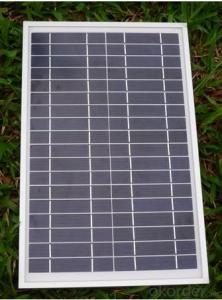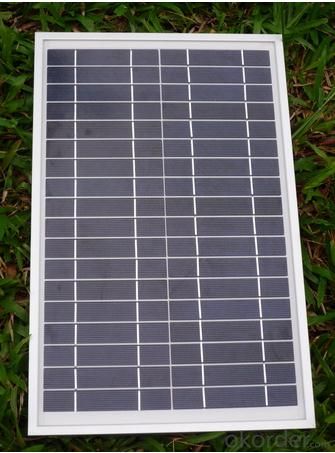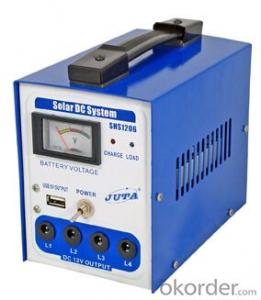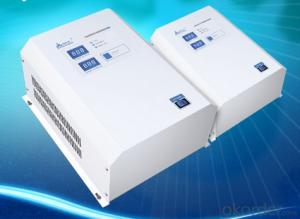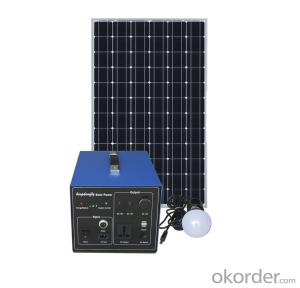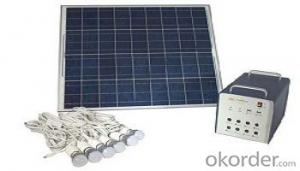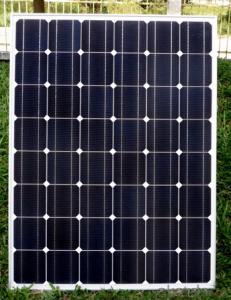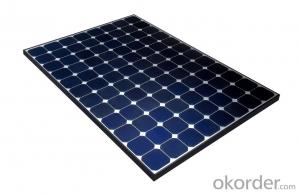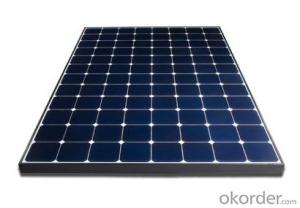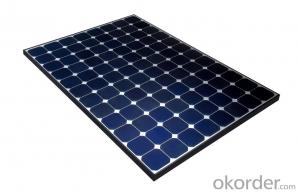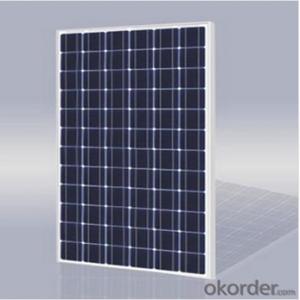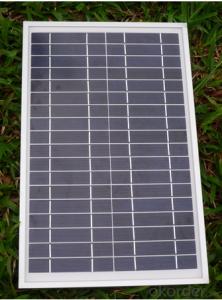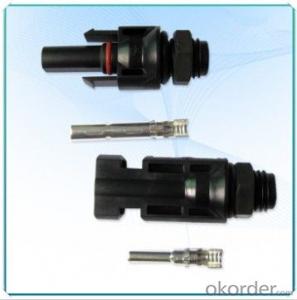35kw CNBM Monocrystalline Silicon Solar Energy Systems Panel for Home Use in Italy
- Loading Port:
- Tianjin
- Payment Terms:
- TT OR LC
- Min Order Qty:
- 100 watt
- Supply Capability:
- 1000 watt/month
OKorder Service Pledge
OKorder Financial Service
You Might Also Like
Specification
35KW CNBM Monocrystalline Silicon Panel for Home Using
Production description
Solar energy is radiant light and heat from the Sun harnessed using a range of ever-evolving technologies such assolar heating, photovoltaics, solar thermal energy, solar architecture and artificial photosynthesis.
It is an important source of renewable energy and its technologies are broadly characterized as either passive solar oractive solar depending on the way they capture and distribute solar energy or convert it into solar power. Active solar techniques include the use of photovoltaic systems
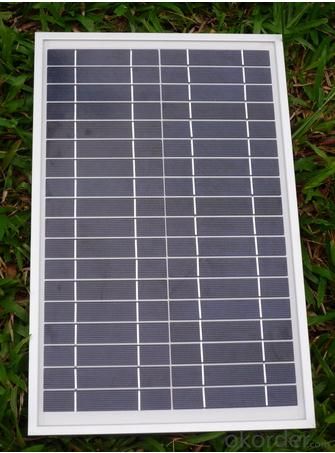
Feature
1.High conversion efficiencies resulting in superior power output performance.
2.Outstanding power output even in low light or high temperature conditions
3.Optimized design for ease of soldering and lamination
Physical characteristic
1. Rigorous quality control meets the highest international standards.
2. High-transmissivity low-iron tempered glass, strong aluminium frame.
3. Using UV-resistant silicon.
4. IS09001/14001/CE/TUV/UL
Packaging
26pcs in one carton 6pallets in 20foot container 14pallets in 40 foot container.
- Q: What is the role of solar energy systems in reducing noise pollution?
- Solar energy systems play a significant role in reducing noise pollution as they operate silently without the need for any mechanical parts or combustion. Unlike traditional energy sources like generators or power plants, solar panels generate electricity through the absorption of sunlight, eliminating noise emissions. This not only provides a quieter and more peaceful environment for nearby communities but also has a positive impact on wildlife, reducing disturbances caused by loud machinery or industrial processes.
- Q: What is the role of inverters in a solar energy system?
- The role of inverters in a solar energy system is to convert the direct current (DC) electricity produced by solar panels into alternating current (AC) electricity that can be used to power common household appliances and be fed into the electrical grid.
- Q: Are solar energy systems affected by hail or other weather conditions?
- Solar energy systems can be affected by hail or other severe weather conditions to some extent. Hailstorms can potentially damage solar panels, especially if the hailstones are large in size or the panels do not have sufficient protection. Hailstones can crack or shatter the glass covering of solar panels, leading to reduced efficiency or even complete failure of the affected panels. However, it is important to note that solar panels undergo rigorous testing and are designed to withstand various weather conditions, including hail. Most solar panels are built to withstand hailstones of a certain size and are often tested for impact resistance. Panels that meet international standards are generally equipped to handle hailstones up to a certain diameter without significant damage. Furthermore, technological advancements have led to the development of more durable and resilient solar panels. Manufacturers are continuously improving the materials used in solar panel construction to enhance their ability to withstand hail, extreme temperatures, and other weather-related challenges. In regions prone to hail or severe weather, additional protective measures can be taken to minimize the risk of damage. These measures may include using hail-resistant glass, installing protective screens or barriers, or tilting the solar panels to reduce their exposure to hail. Overall, while solar energy systems can be affected by hail or other severe weather conditions, the risk of damage is generally considered low, especially with properly installed and tested systems. Additionally, the long-term benefits and environmental advantages of solar energy outweigh the potential risks associated with weather-related damage.
- Q: Can a solar energy system be installed in an area with a high fire risk?
- Yes, a solar energy system can be installed in an area with a high fire risk. However, certain precautions and considerations need to be taken to ensure the safety of the system and minimize the fire risk. Firstly, it is important to choose high-quality solar panels and equipment that meet fire safety standards. This includes using materials that are fire-resistant and have been tested for their ability to withstand high temperatures and potential fire hazards. Secondly, the installation should adhere to local building codes and regulations related to fire safety. This may involve maintaining specific clearances between the solar panels and nearby flammable materials, such as trees or buildings. Additionally, the system should be designed to minimize the risk of fire spreading, for example, by incorporating fire breaks or isolating electrical components. Regular maintenance and inspection of the solar energy system are crucial in areas with high fire risk. This includes removing any debris or vegetation that could potentially pose a fire hazard, ensuring the system is free from any damage or loose connections that could lead to electrical faults or sparking. In case of a fire emergency, it is important to have a clear plan in place to safely shut down the solar energy system and disconnect it from the electrical grid. This should be communicated to emergency responders to ensure their safety during firefighting efforts. Overall, while a solar energy system can be installed in an area with a high fire risk, it requires careful planning, proper equipment selection, adherence to safety regulations, and regular maintenance to minimize the fire risk and ensure the safety of the system and surrounding environment.
- Q: Can solar energy systems be used in areas with limited technological infrastructure?
- Yes, solar energy systems can be used in areas with limited technological infrastructure. Solar energy systems are often modular and can be easily installed and maintained. They do not require a complex grid infrastructure or extensive technical expertise. Additionally, advancements in solar technology have led to the development of off-grid solar solutions, such as solar lanterns and portable solar panels, which can provide basic energy needs in remote areas. Therefore, solar energy systems offer a viable and sustainable solution for areas with limited technological infrastructure.
- Q: Can solar energy systems be used in powering amusement arcades or gaming centers?
- Yes, solar energy systems can definitely be used to power amusement arcades or gaming centers. Solar energy systems convert sunlight into electricity, providing a clean and renewable source of power. By installing solar panels on the roofs of these facilities or in nearby areas with sufficient sunlight exposure, the generated electricity can be used to run the arcade machines, gaming consoles, lighting, air conditioning, and other electrical equipment within the establishment. In addition to reducing electricity bills, solar energy systems also have long-term cost savings and offer a sustainable solution that aligns with the growing demand for environmentally friendly operations.
- Q: Can solar energy systems be used for powering electric bike charging stations?
- Yes, solar energy systems can be used to power electric bike charging stations. Solar panels can generate electricity from sunlight, which can then be used to charge electric bikes. This renewable and sustainable energy source is a great option for powering charging stations, reducing reliance on traditional energy sources and promoting eco-friendly transportation.
- Q: Are there any risks of electrical grounding issues with solar energy systems?
- Solar energy systems can pose several risks due to electrical grounding issues. One major risk is the potential for electric shock, which occurs when the grounding system is not correctly installed or maintained. This can cause a buildup of electrical current, leading to contact with live electrical components and subsequent shock. Another risk is the possibility of fire. When the grounding system is improperly installed, it can result in electrical arcing, which can ignite a fire. This is especially hazardous as solar energy systems are often situated on rooftops, making it easier for a fire to rapidly spread throughout the entire building. Furthermore, a faulty grounding system can cause damage to the solar energy system itself. Without proper grounding, electrical surges and fluctuations can occur, harming sensitive components like inverters and batteries. To mitigate these risks, it is essential to ensure the proper installation and regular inspection and maintenance of the grounding system in a solar energy system. This involves using appropriate grounding equipment like grounding rods or conductors, as well as ensuring all connections are secure and free from corrosion. Regular testing should also be carried out to assess the effectiveness of the grounding system. It is advisable to enlist the services of a qualified professional for the installation and maintenance of the grounding system to minimize the hazards associated with electrical grounding issues in solar energy systems.
- Q: What is the role of inverters in solar energy systems?
- The role of inverters in solar energy systems is to convert the direct current (DC) electricity generated by the solar panels into alternating current (AC) electricity, which can be used to power homes, businesses, and other electrical appliances. Inverters also ensure that the AC electricity produced matches the frequency and voltage requirements of the electrical grid, enabling seamless integration and distribution of solar power.
- Q: What is the role of disconnect switches in a solar energy system?
- Disconnect switches play a crucial role in a solar energy system by providing a means to safely isolate the system from the grid or other power sources. These switches act as a safeguard during maintenance, repairs, or emergencies, allowing for the complete disconnection of the solar panels or inverters from the electrical grid. One of the primary functions of disconnect switches is to protect both the system and the individuals working on it. They prevent the flow of electricity from the solar panels to the grid, ensuring that no power is being generated or transferred while maintenance or repairs are being carried out. This helps to minimize the risk of electric shocks or accidents. Disconnect switches also serve as a means of complying with safety regulations and codes. They allow for easy and quick disconnection of the solar energy system, which is often required during inspections or in case of emergencies such as fires or natural disasters. By isolating the system, disconnect switches help prevent any potential damage to the system or the grid. Moreover, disconnect switches enable the efficient monitoring and control of the solar energy system. They provide a convenient way to shut down the system when necessary, allowing for troubleshooting or routine checks. By disconnecting the solar panels, inverters, or battery storage systems, these switches help optimize the efficiency and performance of the overall system. In summary, the role of disconnect switches in a solar energy system is to ensure the safety of individuals working on the system, comply with safety regulations, protect the system and the grid from potential damage, and facilitate efficient monitoring and control. These switches are an essential component that allows for the safe and effective operation of solar energy systems.
Send your message to us
35kw CNBM Monocrystalline Silicon Solar Energy Systems Panel for Home Use in Italy
- Loading Port:
- Tianjin
- Payment Terms:
- TT OR LC
- Min Order Qty:
- 100 watt
- Supply Capability:
- 1000 watt/month
OKorder Service Pledge
OKorder Financial Service
Similar products
Hot products
Hot Searches
Related keywords
